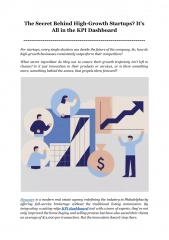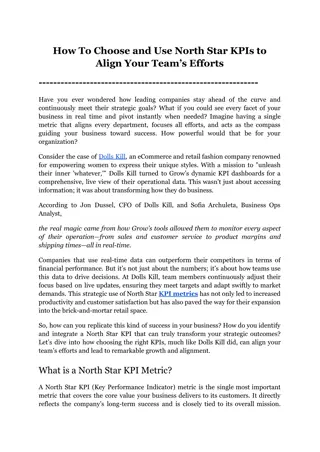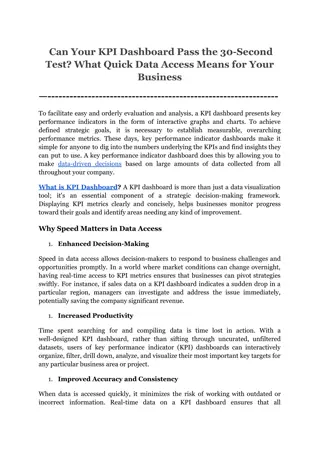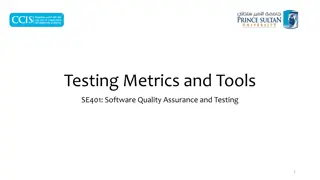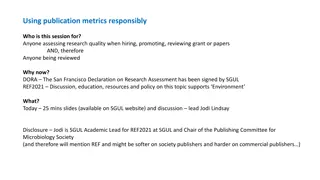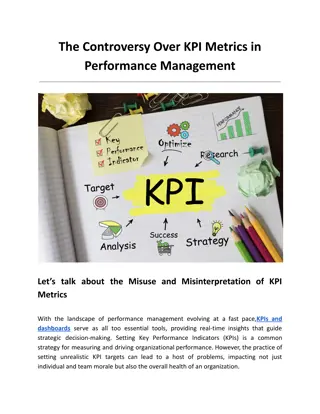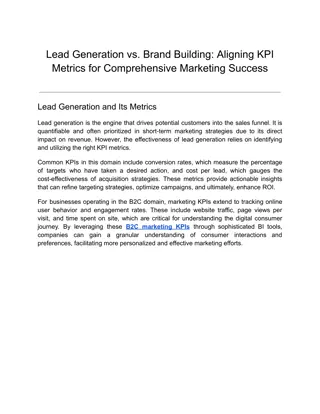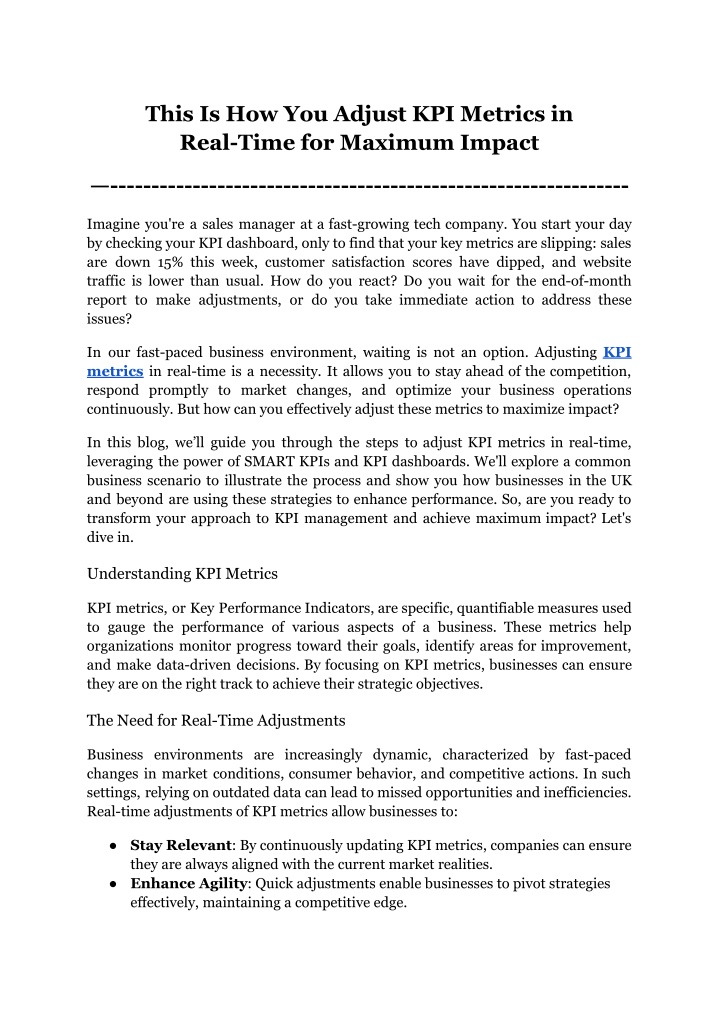
This Is How You Adjust KPI Metrics in Real-Time for Maximum Impact
Discover how to stay ahead in today's fast-paced business environment by adjusting KPI metrics in real-time. This blog outlines practical steps for identifying critical KPIs, setting up real-time data feeds, implementing automated alerts, and making informed decisions using SMART KPIs and KPI dashboards.
Download Presentation

Please find below an Image/Link to download the presentation.
The content on the website is provided AS IS for your information and personal use only. It may not be sold, licensed, or shared on other websites without obtaining consent from the author. If you encounter any issues during the download, it is possible that the publisher has removed the file from their server.
You are allowed to download the files provided on this website for personal or commercial use, subject to the condition that they are used lawfully. All files are the property of their respective owners.
The content on the website is provided AS IS for your information and personal use only. It may not be sold, licensed, or shared on other websites without obtaining consent from the author.
E N D
Presentation Transcript
This Is How You Adjust KPI Metrics in Real-Time for Maximum Impact --------------------------------------------------------------- Imagine you're a sales manager at a fast-growing tech company. You start your day by checking your KPI dashboard, only to find that your key metrics are slipping: sales are down 15% this week, customer satisfaction scores have dipped, and website traffic is lower than usual. How do you react? Do you wait for the end-of-month report to make adjustments, or do you take immediate action to address these issues? In our fast-paced business environment, waiting is not an option. Adjusting KPI metrics in real-time is a necessity. It allows you to stay ahead of the competition, respond promptly to market changes, and optimize your business operations continuously. But how can you effectively adjust these metrics to maximize impact? In this blog, we ll guide you through the steps to adjust KPI metrics in real-time, leveraging the power of SMART KPIs and KPI dashboards. We'll explore a common business scenario to illustrate the process and show you how businesses in the UK and beyond are using these strategies to enhance performance. So, are you ready to transform your approach to KPI management and achieve maximum impact? Let's dive in. Understanding KPI Metrics KPI metrics, or Key Performance Indicators, are specific, quantifiable measures used to gauge the performance of various aspects of a business. These metrics help organizations monitor progress toward their goals, identify areas for improvement, and make data-driven decisions. By focusing on KPI metrics, businesses can ensure they are on the right track to achieve their strategic objectives. The Need for Real-Time Adjustments Business environments are increasingly dynamic, characterized by fast-paced changes in market conditions, consumer behavior, and competitive actions. In such settings, relying on outdated data can lead to missed opportunities and inefficiencies. Real-time adjustments of KPI metrics allow businesses to: Stay Relevant: By continuously updating KPI metrics, companies can ensure they are always aligned with the current market realities. Enhance Agility: Quick adjustments enable businesses to pivot strategies effectively, maintaining a competitive edge.
For example, in the UK retail sector, real-time monitoring of sales data through a KPI dashboard can help stores adjust inventory levels instantly, ensuring high-demand products are always in stock. Benefits of Real-Time Adjustments 1. Increased Responsiveness: Real-time adjustments to KPI metrics ensure that businesses can respond promptly to emerging trends and potential issues. For instance, a UK-based e-commerce company can use real-time KPI dashboards to track website traffic and conversion rates, enabling immediate action if a sudden drop in traffic is detected. 2. Improved Decision-Making: Access to up-to-date KPI metrics facilitates better decision-making processes. Decision-makers can leverage SMART KPIs to set specific, measurable, achievable, relevant, and time-bound objectives, ensuring that every action taken is aligned with strategic goals. 3. Optimized Performance: Continuous monitoring and adjustment of KPI metrics lead to optimized business performance. For example, manufacturing companies in the UK can use real-time data to adjust production schedules, minimizing downtime and maximizing efficiency. Tools and Technologies for Real-Time Adjustments The implementation of real-time adjustments requires robust tools and technologies. Key among these are KPI dashboards and integrated data systems: KPI Dashboards: KPI dashboards provide a visual representation of real-time data, allowing businesses to monitor key metrics at a glance. These dashboards can be customized to display specific KPI metrics relevant to different business functions, from sales and marketing to operations and finance. In the US, UK and across the globe, companies often use KPI dashboards to track metrics such as revenue growth, customer satisfaction, and operational efficiency. Integrated Data Systems: Real-time adjustments rely on the seamless integration of data from various sources. Using APIs and data connectors, businesses can ensure that their KPI dashboards are fed with the most current data available, facilitating timely adjustments. 2
Steps to Adjust KPI Metrics in Real-Time Adjusting KPI metrics in real-time is crucial for maintaining business agility and ensuring timely responses to market changes. Step 1: Identify Critical KPI Metrics The first step in adjusting KPI metrics in real-time is to identify the most critical KPIs that drive your business. These should be metrics that directly impact your strategic goals and operational performance. Focus on Relevance: Choose KPIs that align with your business objectives. For example, a retail business might prioritize sales per square foot, while a manufacturing company might focus on production efficiency. Use Historical Data: Analyze past performance data to determine which KPIs have the most significant influence on your business outcomes. In the UK, businesses often focus on KPIs like customer satisfaction and revenue growth to stay competitive in a dynamic market. Step 2: Set Up Real-Time Data Feeds To adjust KPI metrics in real-time, you need a continuous flow of accurate data. Setting up real-time data feeds ensures that your KPI dashboard is always up-to-date. Integrate Data Sources: Use APIs and data connectors to integrate data from various sources, such as CRM systems, financial software, and operational databases. Ensure Data Accuracy: Implement data validation processes to maintain the accuracy and reliability of your KPI metrics. For example, a UK-based e-commerce company might integrate real-time sales data, website analytics, and customer feedback into their KPI dashboard to monitor performance continuously. Step 3: Implement Automated Alerts Automated alerts are essential for real-time KPI adjustments. They notify you immediately when a KPI metric in the UK or elsewhere, deviates from its expected range, enabling prompt action. Define Alert Thresholds: Set specific thresholds for each KPI metric. For instance, an alert might trigger if sales drop by more than 10% in a day. Customize Notifications: Tailor alerts to the needs of different stakeholders. A sales manager might need instant notifications for revenue dips, while a customer service leader might focus on response times. 3
Incorporating SMART KPI systems into your alerts ensures that they are specific, measurable, achievable, relevant, and time-bound. Step 4: Analyze and Interpret Data Quickly Real-time adjustments require quick and accurate data interpretation. Use KPI dashboards to visualize data and identify trends immediately. Leverage Visualization Tools: KPI dashboards provide a visual representation of data, making it easier to spot patterns and anomalies. Conduct Rapid Analysis: Use real-time data analysis tools to interpret KPI metrics quickly. This might involve comparing current performance against historical trends or benchmarking against industry standards. For example, a UK financial services firm might use a KPI dashboard to monitor market fluctuations and adjust investment strategies in real time. Step 5: Make Informed Decisions Once you have analyzed the data, the next step is to make informed decisions based on your findings. This involves developing a decision-making framework that incorporates real-time insights. Develop Action Plans: Create actionable plans for different scenarios. For instance, if customer satisfaction drops, have a strategy ready to address the issue promptly. Empower Teams: Ensure that teams have the authority and tools to act on real-time data. This might involve delegating decision-making power to frontline managers or setting up cross-functional teams. Using SMART KPI solutions helps ensure that the decisions made are aligned with your business objectives and are time-bound for prompt action. Conclusion Adjusting KPI metrics in real-time is a game-changer for businesses aiming to maintain agility and drive continuous improvement. By following the steps outlined in this blog identifying critical KPIs, setting up real-time data feeds, implementing automated alerts, analyzing data quickly, and making informed decisions you can ensure your business stays responsive and competitive in today s fast-paced environment. Leveraging tools like SMART KPIs and KPI dashboards, you gain valuable insights that enable you to optimize performance and make data-driven decisions. Businesses in the UK and around the world are already seeing the benefits of real-time KPI adjustments, with increased efficiency, profitability, and customer satisfaction. 4
One powerful tool to help you achieve this is Grow. With Grows robust BI platform, you can easily monitor and adjust your KPI metrics in real-time. Its intuitive KPI dashboards provide you with up-to-date insights, allowing you to make immediate and impactful decisions. Are you ready to step up your KPI management? Try Grow with a 14-day free trial and experience the difference firsthand. To learn more about how Grow can benefit your business, check out the Grow Cost & Reviews on Capterra. Start your journey towards smarter, real-time KPI adjustments today and see the maximum impact on your business performance. 5


